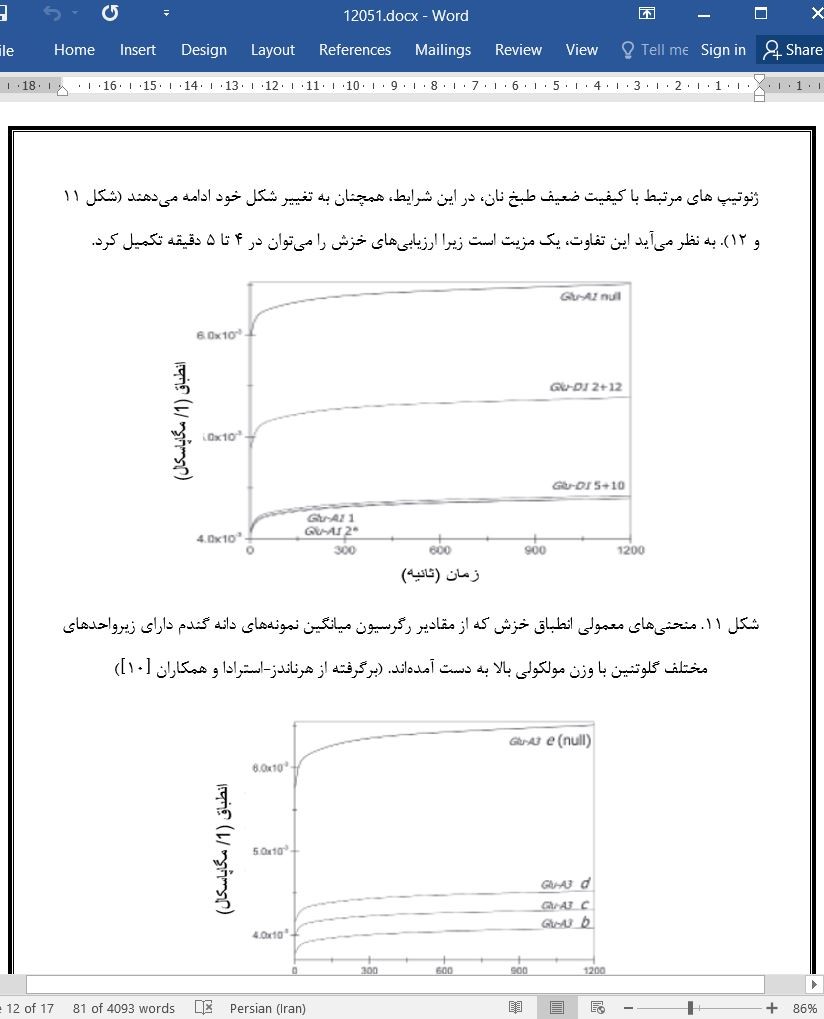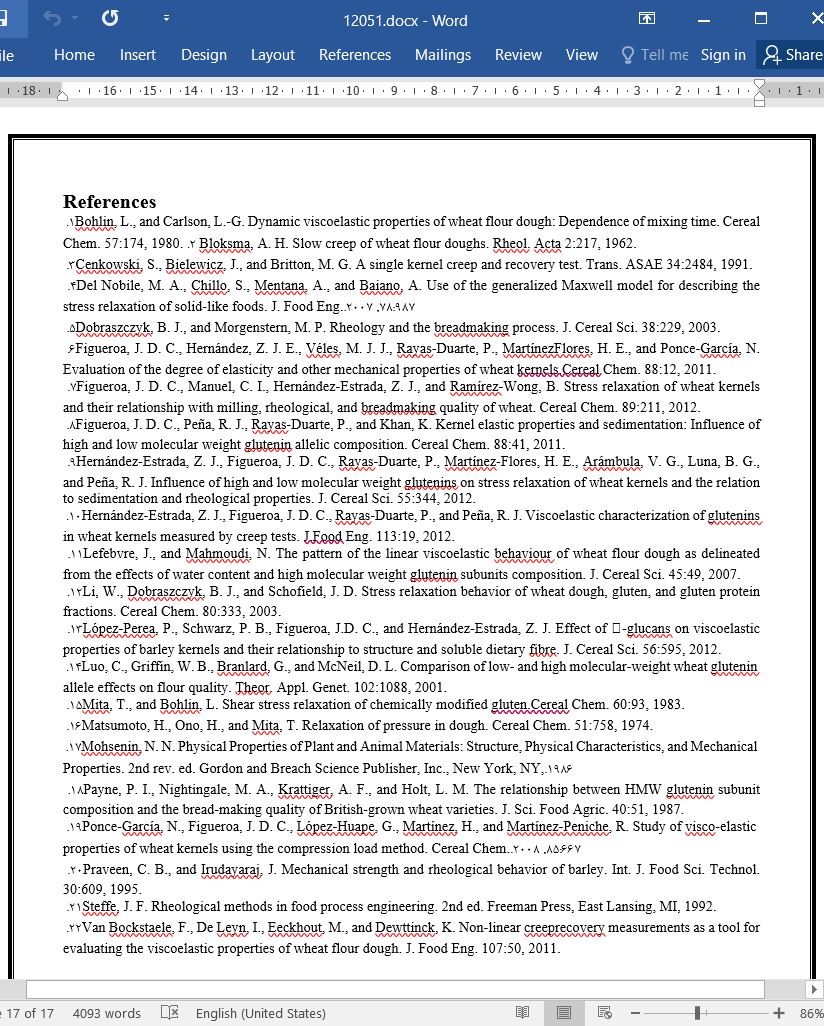
آزمایش رهاسازی تنش و بازیابی خزش انجام شده بر روی دانه گندم در مقایسه با خمیر آن
محققین نشان داده¬اند که تمام دگرشکلیهای الاستیک-پلاستیک محصولات کشاورزی را میتوان با نظریه ویسکوالاستیک توضیح داد. این روش برای سنجش تفاوتهای ویسکوالاستی رفتار محصول تحت بار با پاسخ مدل دارای خواص ویسکوالاستی یا رئولوژی ایده آل، بکار رفت. برای انجام این نوع آنالیز، لازم است در مورد پراکندگی تنش در مواد بارگذاری شده، آگاهی داشته باشیم. چنین اطلاعاتی توضیح میدهند که چطور ساختار یک ماده میتواند پذیرای بارهای اعمال شده، باشد و مکانیزم های گسیختگی مواد را را بیان میکنند.
آزمونهای رهاسازی تنش
در آزمونهای رهاسازی تنش، کشش ثابتی اعمال میشود و تنش لازم برای حفظ دگرشکلی به عنوان تابعی از زمان، اندازه گیری میگردد. زمان رهاسازی اندازه گیری شده، نشان میدهد که ماده پس از تغییرشکل ناگهانی، چقدر سریع تنش را از بین میبرد. از آنجایی که آسیب مکانیکی وارد شده به محصولات کشاورزی معمولاً ناشی از بارهای فشاری هستند، بنابراین دادههای آزمون فشرده سازی، بیشتر از دادههای آزمون کششی (17) میباشند. رفتارهای مختلفی هنگام انجام آزمون رهاسازی تنش، مشاهده میشود: مواد الاستیک ایده آل بلافاصله پس از رفع تنش شروع به رهاسازی نمیکنند، در حالی که مواد سیال ایده آل بلافاصله رهاسازی را آغاز مینمایند. مواد جامد ویسکوالاستی به تدریج از تنش رها میشوند و در مقادیر بالاتر از صفر به تعادل میرسند؛ در حالی که تنش باقی مانده برای مایعات ویسکوالاستیک صفر است (4،21). رهاسازی تنش را میتوان با استفاده از مدلهایی که توصیف کننده اتفاقات رخ داده برای ساختارهای مولکولی مواد هستند بررسی کرد.
نتیجه گیری
ما نمونههایی از معیارهای پایهای برای ارزیابی ویسکوالاستی دانههای گندم و خمیر آن با استفاده از تست رهاسازی تنش، آزمون خزش و آزمون بازیابی خزش را خلاصه کردهایم. غالباً تنها روش برای تعیین کیفیت موردقبول پرورش دهندگان گیاهان، آسیابان ها و نانوایان، آزمایش طبّاخی نان (پخت نان) است. غالباً از آزمایشات رئولوژیکی اولیه برای مطالعات پایهایتر استفاده میشود؛ اما کاربرد این ازمایشات برای توصیف تعداد زیادی از ارقام غلات، به اندازه کافی گسترده و همه جانبه نیست. علاوه براین، روابط بین خواص رئولوژی پایهای و کیفیت پخت، به اندازه کافی مورد بررسی قرار نگرفته است.
Researchers have shown that the overall elastic-plastic deformation of agricultural products can be explained by the theory of viscoelasticity. The method employed to measure viscoelasticity compares the behavior of the product under load with the response of an idealized viscoelastic or rheological model. To perform this type of analysis it is necessary to have some knowledge of stress distribution in loaded materials. Such information provides an explanation of how the structure of a material is able to support applied loads and explains the mechanisms of failure.
Stress Relaxation Tests
In stress relaxation tests, a constant strain is applied, and the stress required to maintain the deformation is measured as a function of time. The measured relax ation time indicates how fast the material dissipates stress after sudden deformation. Because mechanical damage to agricultural products usually results from compressive loads, more data can be found for compression tests than for tensile tests (17). When a stress relaxation test is performed, different behaviors are observed: ideal elastic materials do not immediately begin to relax, whereas ideal viscous materials instantaneously begin to relax. Viscoelastic solids gradually relax and reach an equilibrium stress greater than zero, whereas the residual stress for viscoelastic fluids is zero (4,21). Stress relaxation can be examined using models to assist in describing what is happening to structures at the molecular level.
Conclusions
We have summarized examples of fundamental measurements of viscoelasticity of wheat kernels and doughs using stress relaxation, creep, and creep recovery tests. Often, the only method for determining quality accepted by plant breeders, millers, and bakers is a baking test. Fundamental rheological tests are frequently applied for more basic studies, but their use is not widespread enough for the characterization of a large number of cultivars. In addition the relationships between fundamental rheology and baking quality have not been sufficiently examined.
آزمونهای رهاسازی تنش
خصوصیات دانه و خمیر گندم و کیفیت طبخ نان
ویژگیهای ویسکوالاستی و فیزیکوشیمیایی
خواص رئولوژیکی و کیفیت طبخ نان
خمیر در برابر خواص رئولوژيکی و کیفیت طبخ نان
ویسکوالاستی دانه گندم، رهاسازی تنش و سختی آن
خزش و آزمونهای بازیابی خزش
شرایط خزش و مدل جامع کلوین-ویت
برگر(Burger) و مدل جامع کلوین-ویت
تأثیر ترکیبات HMW-GS و LMW-GS.
نتیجه گیری
منابع
Stress Relaxation Tests
Wheat Kernel and Dough Properties and Breadmaking Quality
Viscoelasticity and Physicochemical Characteristics
Rheological Properties and Breadmaking Quality
Dough Versus Rheological Properties and Breadmaking Quality
Wheat Kernel Viscoelasticity, Stress Relaxation, and Hardness
Creep and Creep Recovery Tests
Burger and Generalized Kelvin-Voigt Model
Effect of HMW-GS and LMW-GS Composition
Measurement of Creep Compliance of Wheat Kernels Versus Wheat Dough
Conclusions
References
- اصل مقاله انگلیسی با فرمت ورد (word) با قابلیت ویرایش
- ترجمه فارسی مقاله با فرمت ورد (word) با قابلیت ویرایش، بدون آرم سایت ای ترجمه
- ترجمه فارسی مقاله با فرمت pdf، بدون آرم سایت ای ترجمه



